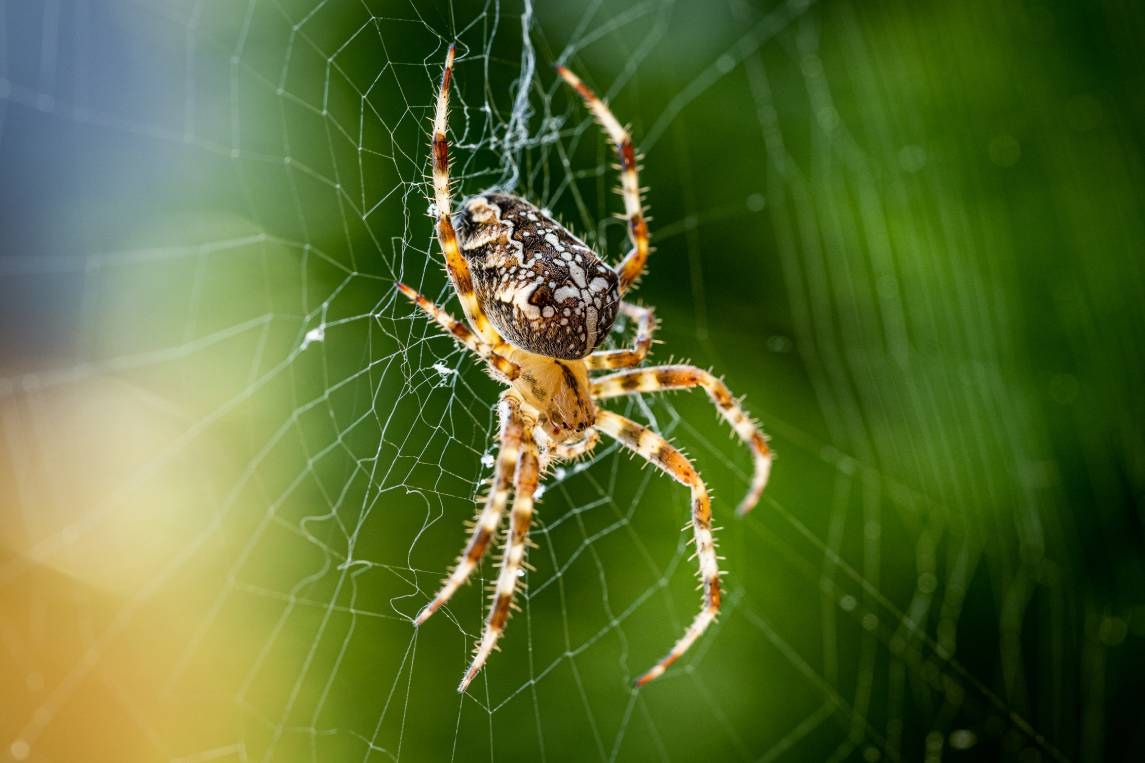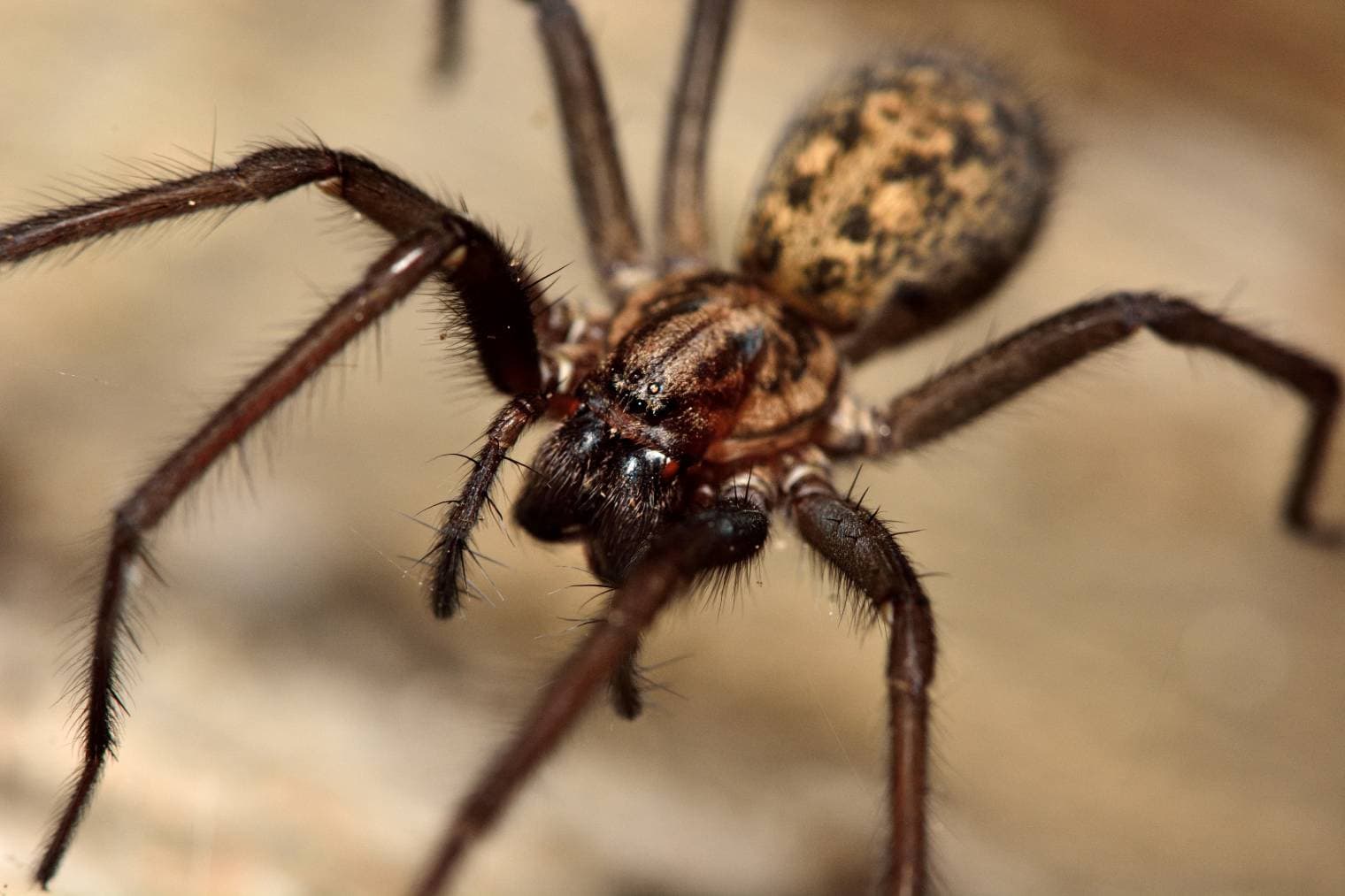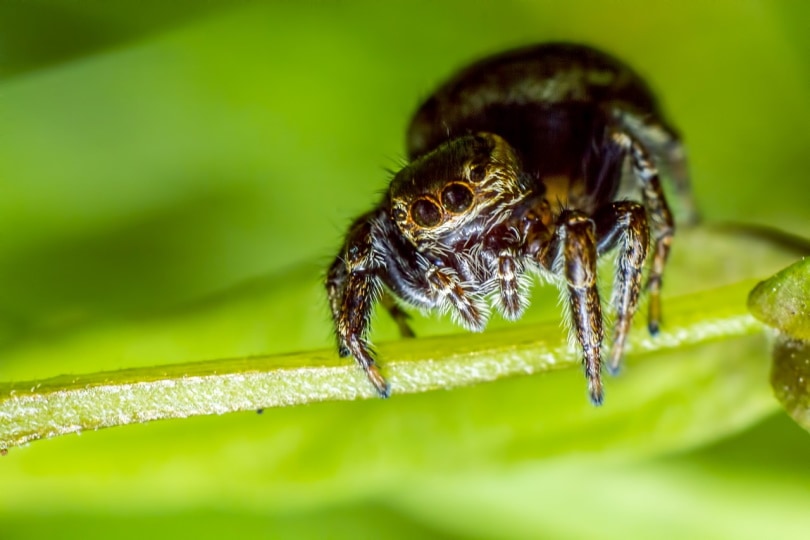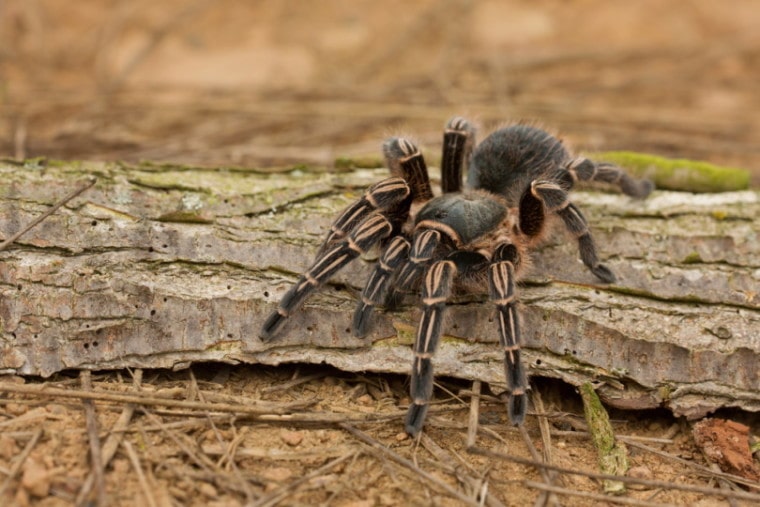
Costa Rican Zebra Tarantulas are a great choice of pet if you are an experienced spider owner. Although these tarantulas are not particularly difficult to take care of, they are very skittish, meaning they require the gentle hand of a skilled spider owner.
When in the right hands, Costa Rican Zebra Tarantulas are incredibly docile and interesting to look at. From the stripes on their legs to their large bodies, these tarantulas can open up your eyes to the wonders of the spider world.
Quick Facts About Costa Rican Zebra Tarantulas
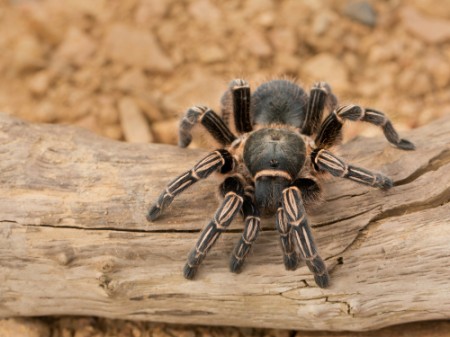
| Species Name: | Aphonopelma seemani |
| Family: | Aphonopelma |
| Care Level: | Intermediate |
| Temperature: | 70 – 85 degrees Fahrenheit; 75% – 80% humidity |
| Temperament: | Docile but skittish |
| Color Form: | Black with white stripes on the legs |
| Lifespan: | 15 – 20 years (female); 5 years (male) |
| Size: | 10 – 13 centimeters |
| Diet: | Live insects like crickets, grasshoppers, beetles, or roaches |
| Minimum Tank Size: | 5 – 10 gallons |
| Tank Set-Up: | 4-inch bedding substrate with plants and water bowl |
| Compatibility: | Intermediate spider owners; people who do not care to hold their spiders |
Costa Rican Zebra Tarantula Overview
Costa Rican Zebra Tarantulas are a type of tarantula native to Guatemala, Nicaragua, and, of course, Costa Rica. You may know this tarantula by another name, the Striped-Knee Tarantula, because of its beautiful body and stripes on its legs.
Natural Habitat
In the wild, these spiders live in large communities and create large burrows. These burrows protect them from the harsh temperatures of their natural environment. When in captivity, these tarantulas are pretty easy to care for, but they are better suited for people who have owned spiders before.
Temperament
Costa Rican Zebra Tarantulas are very skittish, meaning they don’t like being handled as much as other tarantula varieties. Because of this fact, they require intermediate care level.
Care Level
Other than their more skittish nature, Costa Rican Zebra Tarantulas are pretty easy to take care of. You need to make sure that their tank provides the proper habitat suitable for tarantulas and that they get enough food and humidity.
Even though Costa Rican Zebra Tarantulas are docile, they do have barb-like hairs, just like any other tarantula. Whenever the tarantula perceives danger, the hairs can be ejected, which can cause mild skin irritation.
The tarantula also comes with venom that is mildly toxic to humans, though Costa Rican Zebra Tarantulas are not likely to eject venom unless you are being rough with it and it feels it has no other options.
Lifespan
One thing you need to think about before buying a Costa Rican Zebra Tarantula is how long you want to have the tarantula. The males and females have very different life expectancies.
Females can live between 15 and 20 years, whereas males only live five years. Select a male if you aren’t fully committed to having a tarantula for two decades.
So long as you know how to be gentle with the spider, Costa Rican Zebra Tarantulas will be a good choice for you. If you want a spider that you can hold more frequently, we recommend a different variety.
How Much Do Costa Rican Zebra Tarantulas Cost?
Costa Rican Zebra Tarantulas are considered relatively common tarantulas. If you go to a pet store with exotic pets, they will likely have Costa Rican Zebra Tarantulas or similar alternatives. Because Costa Rican Zebra Tarantulas are so common in the exotic pet world, you will likely only have to pay between $20 and $40.
Keep in mind that you will have to pay for the Costa Rican Zebra Tarantula’s food, housing, and tank setup. Once you have the tank and the spider, the only thing you will need to buy frequently is food and water.
Typical Behavior & Temperament
Costa Rican Zebra Tarantulas are incredibly docile, but they are much more skittish than other spider types. Whenever alarmed, the spider can and will run really quickly, making them next to impossible to catch.
Because they are skittish, this is not the best spider for you if you want to hold your spider. With that being said, you can begin handling the spider through daily socialization and gentle introduction. Be incredibly cautious when handling the spider because it is likely to get hurt if it runs away while being held.
Appearance & Varieties
One thing that makes Costa Rican Zebra Tarantulas a favorite among hobbyists is their stunning look. These tarantulas have a black body with deep red hairs. They have yellow spinnerets and white stripes on their legs.
These white stripes are what cause the spider to sometimes be called the Striped-Knee Tarantula. As this nickname suggests, the stripes go down the leg at the bends, almost like a knee covering.
Although some tarantula varieties have different appearances, the same is not true for Costa Rican Zebra Tarantulas. All Costa Rican Zebras will look as described above.
How to Take Care of Costa Rican Zebra Tarantulas
Caring for a Costa Rican Zebra Tarantula is relatively easy. As long as you get the right tank, bedding, temperature, and humidity, your Costa Rican Zebra Tarantula should be really hardy and live happily and healthily.
Habitat, Tank Conditions & Setup
Costa Rican Zebra Tarantulas are relatively easy to care for. Their tank should be 5 to 10 gallons in size. The general rule of thumb is that the width of the tank should be three times wider than the tarantula’s legs if not more.
Additionally, the height of the tank should be thick enough so that you can place a thick substrate within the tank for burrowing.
More important is the fact that the tank must be designed so that it is escape-proof. Many spiders, Costa Rican Zebra Tarantulas included, climb really well and can escape if given the chance.
Bedding
Because this type of tarantula burrows in the wild, you need to replicate this by providing a substrate bedding that is 4 inches thick or thicker. The bedding should be made from a mixture of soil, peat moss, and vermiculite. Add a house or some other hollowed-out container for shelter.
Temperature, Humidity, & Lighting
Inside the tank, make sure to keep the temperatures between 70 and 85 degrees Fahrenheit. The humidity level should be between 75% and 80%. You likely won’t need additional heating unless your house is very cool. In that case, simply add a heating pad designed for spiders underneath the habitat.
As for the light, tarantulas do not need additional lamps or excess light. The light from your room and windows is more than enough for these tarantulas.
Do Costa Rican Zebra Tarantulas Get Along with Other Pets?
Costa Rican Zebra Tarantulas should be housed by themselves in a tank. Because of the tank, they should be separated from other animals. Costa Rican Zebra Tarantulas can be frightened by even docile animals.
What to Feed Your Costa Rican Zebra Tarantula
One thing that may be a bit difficult to stomach as a new spider owner is that tarantulas prefer eating live prey. What this means for you is that you will need to raise its food source, which can be either expensive or tough to stomach.
Costa Rican Zebra Tarantulas particularly crickets, grasshoppers, beetles, and cockroaches. Make sure that whatever insect you feed your tarantula eats pesticide-free foliage.
Feed your Costa Rican Zebra Tarantula about once a week. Whenever your tarantula is finished eating, remove any uneaten items from the cage. This includes both live insects and dead ones. The live insects can stress the tarantula, whereas the dead ones can create unhealthy conditions.
Provide constant access to a water bowl and change the water out daily. This water bowl provides additional humidity and water for drinking.
Keeping Your Costa Rican Zebra Tarantula Healthy
Tarantulas are known for being incredibly hardy, meaning they don’t get sick often. However, not providing them the proper nutrition or habitat can lead to fatal consequences.
Make sure to feed your tarantula a healthy diet regularly. Additionally, make sure the habitat is suitable for tarantulas. You especially need to be careful about the humidity. If you notice your tarantula hanging over the water bowl, it is likely looking for hydrated air. This shows that you need to add more humidity to the tank.
Be aware of the molting period. Molting happens whenever the spider is shedding its exoskeleton. During this process, the spider will not eat, will act lazier, and lay on its back with its legs above it. Simply watch your tarantula carefully and leave it be.
Finally, the last thing you need to do to keep your Costa Rican Zebra Tarantula healthy is be careful when handling it. Because this is a skittish breed, they often will try to run away when you are picking it up or holding it. This can lead to a lot of injuries.
Breeding
Costa Rican Zebra Tarantulas are rarely bred in captivity. They are mainly caught as wild specimens in the wild. If you are interested in breeding, you need a mature male and mature female.
Put the male in the female’s enclosure. While there, he may hold the female’s fangs and inject his sperm into it. After they are done mating, you must separate them, or else the female may try to eat the male.
If the breeding was successful, the female should produce an egg sack. Once the eggs have developed, you will take them from the female and put them inside an incubator. Whenever the egg sack is ready, you will cut the sack open. Separate each sling and put each one in different containers.
Are Costa Rican Zebra Tarantulas Suitable for You?
Costa Rican Zebra Tarantulas make great pets for hobbyists and spider lovers. They are beautiful and docile. However, they are skittish and need less stressors than other tarantulas, causing them to be best suited for intermediate spider owners.
Other than their more skittish temperament, these tarantulas are very similar to other tarantulas in care and requirements. This makes them a relatively easy pet to own as long as you understand that this spider may not want to be held or pet.
If you want a tarantula that you can handle, we recommend the Mexican Red Knee Tarantula. If you are perfectly content with a spider that doesn’t want to be handled, the Costa Rican Zebra Tarantula may be a great choice for you.
Featured Image Credit: Milan Zygmut, Shutterstock



